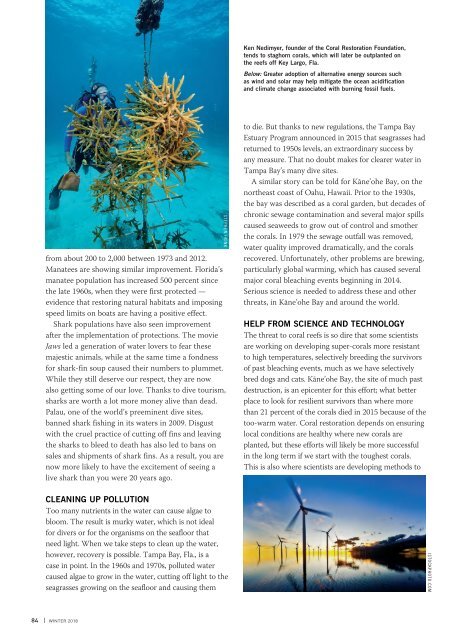AD 2018 Q1
Alert Diver is the dive industry’s leading publication. Featuring DAN’s core content of dive safety, research, education and medical information, each issue is a must-read reference, archived and shared by passionate scuba enthusiasts. In addition, Alert Diver showcases fascinating dive destinations and marine environmental topics through images from the world’s greatest underwater photographers and stories from the most experienced and eloquent dive journalists in the business.
Alert Diver is the dive industry’s leading publication. Featuring DAN’s core content of dive safety, research, education and medical information, each issue is a must-read reference, archived and shared by passionate scuba enthusiasts. In addition, Alert Diver showcases fascinating dive destinations and marine environmental topics through images from the world’s greatest underwater photographers and stories from the most experienced and eloquent dive journalists in the business.
You also want an ePaper? Increase the reach of your titles
YUMPU automatically turns print PDFs into web optimized ePapers that Google loves.
Ken Nedimyer, founder of the Coral Restoration Foundation,<br />
tends to staghorn corals, which will later be outplanted on<br />
the reefs off Key Largo, Fla.<br />
Below: Greater adoption of alternative energy sources such<br />
as wind and solar may help mitigate the ocean acidification<br />
and climate change associated with burning fossil fuels.<br />
from about 200 to 2,000 between 1973 and 2012.<br />
Manatees are showing similar improvement. Florida’s<br />
manatee population has increased 500 percent since<br />
the late 1960s, when they were first protected —<br />
evidence that restoring natural habitats and imposing<br />
speed limits on boats are having a positive effect.<br />
Shark populations have also seen improvement<br />
after the implementation of protections. The movie<br />
Jaws led a generation of water lovers to fear these<br />
majestic animals, while at the same time a fondness<br />
for shark-fin soup caused their numbers to plummet.<br />
While they still deserve our respect, they are now<br />
also getting some of our love. Thanks to dive tourism,<br />
sharks are worth a lot more money alive than dead.<br />
Palau, one of the world’s preeminent dive sites,<br />
banned shark fishing in its waters in 2009. Disgust<br />
with the cruel practice of cutting off fins and leaving<br />
the sharks to bleed to death has also led to bans on<br />
sales and shipments of shark fins. As a result, you are<br />
now more likely to have the excitement of seeing a<br />
live shark than you were 20 years ago.<br />
CLEANING UP POLLUTION<br />
Too many nutrients in the water can cause algae to<br />
bloom. The result is murky water, which is not ideal<br />
for divers or for the organisms on the seafloor that<br />
need light. When we take steps to clean up the water,<br />
however, recovery is possible. Tampa Bay, Fla., is a<br />
case in point. In the 1960s and 1970s, polluted water<br />
caused algae to grow in the water, cutting off light to the<br />
seagrasses growing on the seafloor and causing them<br />
STEPHEN FRINK<br />
to die. But thanks to new regulations, the Tampa Bay<br />
Estuary Program announced in 2015 that seagrasses had<br />
returned to 1950s levels, an extraordinary success by<br />
any measure. That no doubt makes for clearer water in<br />
Tampa Bay’s many dive sites.<br />
A similar story can be told for Kāne’ohe Bay, on the<br />
northeast coast of Oahu, Hawaii. Prior to the 1930s,<br />
the bay was described as a coral garden, but decades of<br />
chronic sewage contamination and several major spills<br />
caused seaweeds to grow out of control and smother<br />
the corals. In 1979 the sewage outfall was removed,<br />
water quality improved dramatically, and the corals<br />
recovered. Unfortunately, other problems are brewing,<br />
particularly global warming, which has caused several<br />
major coral bleaching events beginning in 2014.<br />
Serious science is needed to address these and other<br />
threats, in Kāne’ohe Bay and around the world.<br />
HELP FROM SCIENCE AND TECHNOLOGY<br />
The threat to coral reefs is so dire that some scientists<br />
are working on developing super-corals more resistant<br />
to high temperatures, selectively breeding the survivors<br />
of past bleaching events, much as we have selectively<br />
bred dogs and cats. Kāne’ohe Bay, the site of much past<br />
destruction, is an epicenter for this effort; what better<br />
place to look for resilient survivors than where more<br />
than 21 percent of the corals died in 2015 because of the<br />
too-warm water. Coral restoration depends on ensuring<br />
local conditions are healthy where new corals are<br />
planted, but these efforts will likely be more successful<br />
in the long term if we start with the toughest corals.<br />
This is also where scientists are developing methods to<br />
ISTOCKPHOTO.COM<br />
84 | WINTER <strong>2018</strong>









